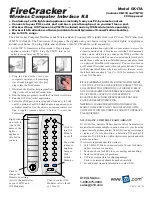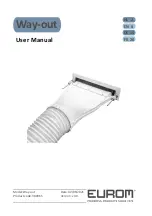
NR01 Four-Component Net Radiation Sensor
11
6.3.2 Using the Datalogger’s Current Excitation Output
The PT100 sensor can connect directly to the CR6, CR3000, and CR5000
dataloggers because they have current excitation outputs (TABLE
).
TABLE 6-5. CR6, CR3000, and CR5000 Connections for Differential Measurement
and using the Current Excitation to Measure the PT100 Sensor
Wire Label
Color
CR6*
CR3000, CR5000
Cable 1 (ensure it is cable 1 before connecting)
Pyranometer Up Sig
Red
U configured as a differential input
Differential Input (H)
Pyranometer Up Ref
**Blue
U configured as a differential input
Differential Input (L)
Pyranometer Down Sig
White
U configured as a differential input
Differential Input (H)
Pyranometer Down Ref
**Green
U configured as a differential input
Differential Input (L)
Pyrgeometer Up Sig
Brown
U configured as a differential input
Differential Input (H)
Pyrgeometer Up Ref
**Yellow
U configured as a differential input
Differential Input (L)
Pyrgeometer Down Sig
Purple
U configured as a differential input
Differential Input (H)
Pyrgeometer Down Ref
*Grey
U configured as a differential input
Differential Input (L)
Cable 2 (ensure it is cable 2 before connecting)
PT100 Signal
**White
U configured as a differential input
Differential Input (H)
PT100 Signal Ref
**Green
U configured as a differential input
Differential Input (L)
Current Excite
**Red
U configured as a current excitation
Current Excitation IX
Current Return -
**Blue
U configured as a current excitation
Current Excitation IXR
Shield (both cables)
Clear
⏚
⏚
*U channels are automatically configured by the measurement instruction.
**Jumper to AG or
⏚
with user-supplied wire.
6.4 Connecting and Using the Heater
Only use the sensor heater when there is risk of dew forming on the sensors,
especially for low power installations. Furthermore, the heater should be
turned on and off infrequently as it may take some time for the sensor to come
to thermal equilibrium. No damage will result if the heater is powered
permanently, but as with all thermopile sensors, it is best if the sensor operates
at ambient temperatures and is not subject to rapidly changes of temperature.
The sensor power can be controlled using one of the 12 V power switches built
into Campbell dataloggers or using an external solid-state switch such as a
PSW12/SW12. The heater current drain is approximately 140 mA from a 12 V
battery. Connect the ground return from the heater, either directly to the
battery, or to a G terminal close the power input to the logger (i.e., not to an
analog ground near the measurement inputs).
The heater power can be controlled by adding instructions to the datalogger
program, that turns on the heater only when the light level falls below
















































